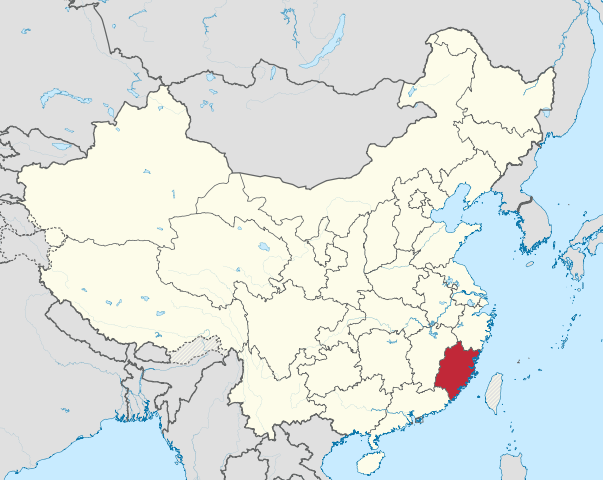 Pirates and Privateers Pirates and Privateers
The History of Maritime
Piracy
Cindy Vallar, Editor
& Reviewer
P.O. Box 425,
Keller, TX 76244-0425
    
A Family
Affair
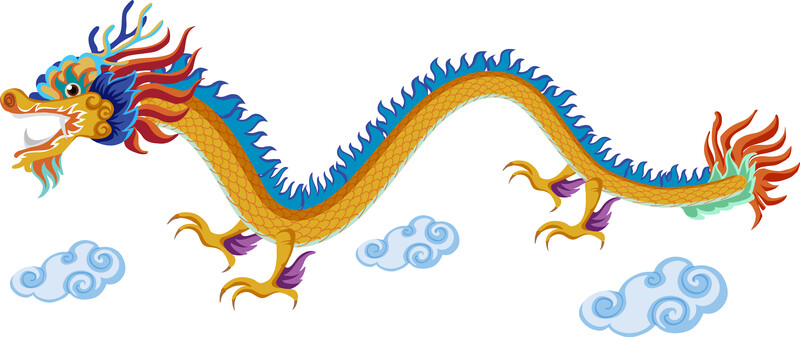
Chinese dragon flying over crowds © bluering (source: CanStockPhoto)
 Long ago in the Land of
the Dragon lived a mischievous and
handsome lad. He and his brothers were not
where they should have been when they
spied lychee on the branch of a tree that
grew behind a wall. Determined to partake
of the sweet, fragrant fruit, they pelted
the bumpy, red husks with stones in hopes
of knocking a cluster from the branch. But
one projectile soared over the wall and
struck the governor. Unable to escape, the
boys found themselves facing this
honorable man. When he looked upon them,
the lad’s seductive charm and smile
beguiled the governor. “This is the face
of one destined for wealth and nobility,”
he said, and dismissed the boys. (Andrade,
Lost, 21) Long ago in the Land of
the Dragon lived a mischievous and
handsome lad. He and his brothers were not
where they should have been when they
spied lychee on the branch of a tree that
grew behind a wall. Determined to partake
of the sweet, fragrant fruit, they pelted
the bumpy, red husks with stones in hopes
of knocking a cluster from the branch. But
one projectile soared over the wall and
struck the governor. Unable to escape, the
boys found themselves facing this
honorable man. When he looked upon them,
the lad’s seductive charm and smile
beguiled the governor. “This is the face
of one destined for wealth and nobility,”
he said, and dismissed the boys. (Andrade,
Lost, 21)
The governor’s words proved prophetic, or
perhaps it was the storytellers who wished
to intrigue their listeners. Whether true
or not, this tale epitomized who this boy
was.
[H]e ran wild, grasped at
hanging fruit, got in trouble, and
came out the better for it. His rise
was so fast, so spectacular, and so
unlikely, that it seemed destiny must
be involved. (Andrade, Lost,
21)
Before we
discover what the fates have in store for
this charismatic lad, we must first learn
about the Land of the Dragon and the
southeastern province where he lives. We
shall also learn about piracy, for it
differs from that of the western world.
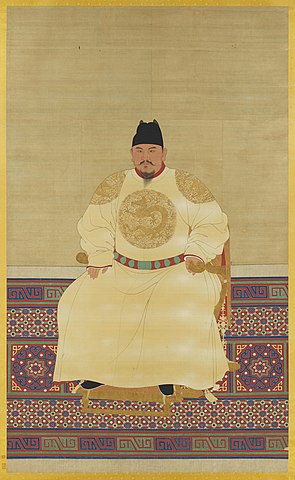 At the time of our story,
the Ming
ruled China and had done so since 1368.
The founder of this dynasty was Zhu
Yuanzhang, who rose to power in
Nanjing and took the name Hongwu, meaning
“Vast Military Power.” For his dynastic
name, he chose Ming because it meant
“brilliant,” and he implemented customs
and traditions that predated the previous
rulers, the Mongols (Yuan
dynasty). They were outlanders, who
had invaded the empire, and they allowed
other foreigners to enter China and
introduce their ways into society. Hongwu
wanted Chinese culture to be the focal
point of life. One way to do this was to
make agriculture a mainstay of her economy
instead of maritime trade. From his
perspective, “Overseas foreign countries .
. . are separated from us by mountains and
seas and faraway in a corner. Their lands
would not produce enough for us to
maintain them; their people would not
usefully serve us if incorporated.”
(Andrade, Company’s, 417) As a result of
this thinking and these policies, the Ming
equated the ocean to the Great
Wall; both were barriers meant to
prevent outlanders from coming into China. At the time of our story,
the Ming
ruled China and had done so since 1368.
The founder of this dynasty was Zhu
Yuanzhang, who rose to power in
Nanjing and took the name Hongwu, meaning
“Vast Military Power.” For his dynastic
name, he chose Ming because it meant
“brilliant,” and he implemented customs
and traditions that predated the previous
rulers, the Mongols (Yuan
dynasty). They were outlanders, who
had invaded the empire, and they allowed
other foreigners to enter China and
introduce their ways into society. Hongwu
wanted Chinese culture to be the focal
point of life. One way to do this was to
make agriculture a mainstay of her economy
instead of maritime trade. From his
perspective, “Overseas foreign countries .
. . are separated from us by mountains and
seas and faraway in a corner. Their lands
would not produce enough for us to
maintain them; their people would not
usefully serve us if incorporated.”
(Andrade, Company’s, 417) As a result of
this thinking and these policies, the Ming
equated the ocean to the Great
Wall; both were barriers meant to
prevent outlanders from coming into China.
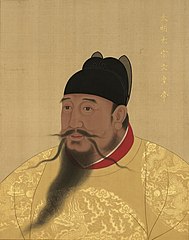 After the emperor’s death
and a brief period of civil war, Hongwu’s
fourth son, Yongle
(“Perpetual Happiness”), came to power.
One of his goals was to extend China’s
influence beyond her borders. He selected
Admiral
Zheng He to make contact with other
countries and establish a network where
outside rulers paid tribute to his
emperor. Zheng He set sail on the first of
seven expeditions in 1405, with
sixty-three ships and 27,870 men; they
traveled as far away as Calicut in India
and returned home two years later. By the
time Zheng He returned from his last
voyage, he had visited Mecca in Arabia and
Mogadishu and Malindi in Africa. After the emperor’s death
and a brief period of civil war, Hongwu’s
fourth son, Yongle
(“Perpetual Happiness”), came to power.
One of his goals was to extend China’s
influence beyond her borders. He selected
Admiral
Zheng He to make contact with other
countries and establish a network where
outside rulers paid tribute to his
emperor. Zheng He set sail on the first of
seven expeditions in 1405, with
sixty-three ships and 27,870 men; they
traveled as far away as Calicut in India
and returned home two years later. By the
time Zheng He returned from his last
voyage, he had visited Mecca in Arabia and
Mogadishu and Malindi in Africa.
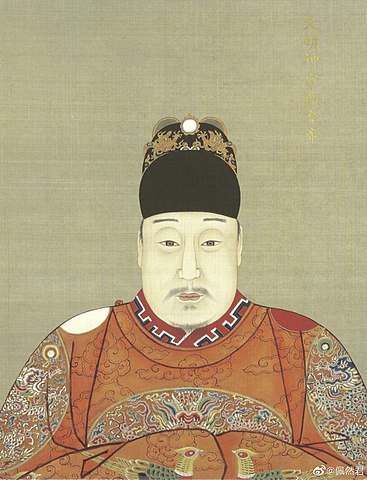 The emperor ruling over
China when our story begins was Wanli,
who came to power when he was ten years
old in 1573. His reign lasted forty-seven
years, the longest of any emperor since Han
Wudi (r. 141 BCE – 87 BCE). It
started with great promise and maritime
trade flourished, but devolved into a slow
decline of the Ming dynasty and the rise
of a new threat from the northeast, the
Manchus. The emperor ruling over
China when our story begins was Wanli,
who came to power when he was ten years
old in 1573. His reign lasted forty-seven
years, the longest of any emperor since Han
Wudi (r. 141 BCE – 87 BCE). It
started with great promise and maritime
trade flourished, but devolved into a slow
decline of the Ming dynasty and the rise
of a new threat from the northeast, the
Manchus.
In the last decade of the sixteenth
century, the people of the provinces of
Fujian and Guangdong suffered a multitude
of natural disasters: droughts,
earthquakes, and floods. These impacted
the availability of food, causing prices
to soar. For many, the only alternatives
to starvation were to become bandits or
pirates.
Piracy is one of the oldest “professions.”
We have no idea how far back in time the
first attack occurs, although the earliest
one that is recorded takes place in 1350
BCE. For China, the first documented
incident happens in AD 589, during the Sui
dynasty, around the same time that Yang
Jian, Emperor Wen of Sui, brings
unity to China.
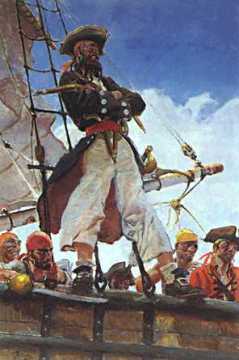 When Westerners hear the
word “piracy,” we have a preconceived idea
of what that comprises. We immediately
summon up the image of a golden age pirate
or a buccaneer. We picture them hunting
alone or in small groups (think Blackbeard
or the joint venture led by Bartholomew
Sharp, John Coxon, Edward Cook,
Richard Sawkins, and Peter Harris). Their
safe havens are few and far between (think
Port
Royal or Madagascar).
They plunder ships, such as Samuel
Bellamy’s capture of the Whydah,
or plunder the wealth of Spain’s colonial
ports, such as Henry
Morgan’s raid on Panama. When Westerners hear the
word “piracy,” we have a preconceived idea
of what that comprises. We immediately
summon up the image of a golden age pirate
or a buccaneer. We picture them hunting
alone or in small groups (think Blackbeard
or the joint venture led by Bartholomew
Sharp, John Coxon, Edward Cook,
Richard Sawkins, and Peter Harris). Their
safe havens are few and far between (think
Port
Royal or Madagascar).
They plunder ships, such as Samuel
Bellamy’s capture of the Whydah,
or plunder the wealth of Spain’s colonial
ports, such as Henry
Morgan’s raid on Panama.
The principal driving force for going
pirating among Westerners is to “get rich
quick.” To a degree this is true among Asian
pirates, but more often, they do so
just to survive. They tend to hunt in
fleets and encounter few, if any, problems
if they put in at major ports. Although
they sometimes pillage vessels and go
raiding, their primary revenue comes from
protection money and ransoms. When it
suits their endgame, they even hire
themselves out as maritime mercenaries.
Even the language used to classify someone
as a pirate differs. In its simplest form,
Westerners define such an offender as a
robber at sea. Chinese historical
documents use terms such as haikou (sea
bandits), haidao (pirates), and haini
(sea rebels). Sometimes kuo is
used, although this word refers to anyone
who engages in robbery regardless of the
type and place where it happens.
We are concerned with China, particularly
the province of Fujian, during the
seventeenth century. This region of
China’s southeast coast extends more than
4,000 kilometers (2,845+ miles) from its
northern border with Zhejiang to Guangdong
to the south. West of the coastline are
mountains, which both isolate the region
from the rest of China and make farming
difficult. As a result, many Fujians turn
to the sea to make their living.
In 1593, the Fujian Censorate told the
Ming court:
The province of Fujian is
short on arable land and densely
populated. Very few of the five grains
are produced. For this reason,
residents along the coast all view the
junk as their home, the seas as their
fields, and trade with the barbarians
as their livelihoods. (Xing, 22)
Just as
predators lurked on the land, they also
were found at sea. “[V]iolence and crime,
like typhoons, taxes, and official
squeeze, were undeniable parts of the
seaman’s daily life.” (Antony, Like,
12) Sometimes, those predators were
victims themselves because “[m]ost pirates
were fishermen and sailors, and fishermen
and sailors were the most frequent victims
of pirates.” (Antony, Like, 12)
It was a time when there was limited legal
maritime trade, because the mandarins
(public officials) kept close watch on
trade and piracy. Too much of the former
might prove too enticing to the latter,
which might endanger the empire’s safety.
When those “red flags” were raised,
imperial decrees instituted prohibitions,
known as Haijin.
The first emperor to implement a sea ban
was Zhu Yuanzhang, because of his
preference for an agricultural empire that
did not require commodities from outside
of China. His subjects could fish, but no
one was permitted to build ships large
enough to visit other countries. The only
foreign trade allowed was that which was
donated, either freely or in payment for
protection, and this was only permitted if
carefully supervised by the authorities.
Tribute trade arrived in one of three
ports and which one a ship put into
depended on where it originated. Those
from Japan sailed to Ningbo. Tribute from
the Ryukyu Islands went to Quanzhou,
although this was later changed to the
capital of Fujian, Fuzhou. Ships from
Southeast Asia and other places docked in
Guangzhou (Canton). Those who violated the
Haijin faced a series of penalties
over the years. In 1501, for example,
THOSE WHO:
1. Build
ships with more than two masts;
2. Or ship
banned goods to foreign countries;
3. Or guide
pirates into coastal areas to rob and
loot;
WILL BE
PUNISHED AS FOLLOWS:
1. The
outlaw himself will be executed [i.e.,
decapitated];
2. His
entire family will be sentenced to
lifetime servitude in military camps
on the frontiers. (Ho, 63)
In 1569, the
following pronouncement was made to those
who lived on the coast.
THOSE WHO dare to trade
sulfur or saltpeter with pirates:
WILL BE
PUNISHED AS FOLLOWS:
1. The
criminal will suffer the death of a
thousand cuts;
2. His
whole family will be executed;
3. His
neighbors, if they knew about the
trade but did not report it, will be
sentenced to lifetime servitude in
military camps on the frontiers;
THOSE WHO
report on such trade will be rewarded
generously . . . (Ho, 65)
The incongruity
of this plan of action that curtailed
legitimate trade was that it often had the
opposite effect. Instead of curbing
piracy, it increased it. It also gave rise
to smuggling. Of course, Westerners, such
as the Vereenigde
Oostindische Compagnie (VOC,
or United East India Company) weren’t
happy with the curtailment of trade with
China, which meant they had to deal with
smugglers and pirate-merchants to acquire
the silks and other luxuries the people
back home desired. It also meant they
might have to use force to gain what they
wanted, in essence turning pirate
themselves.
Nor was there much that imperial forces
could do to thwart the pirates. The
military just didn’t have sufficient
resources or men to counter their
offensives, and corruption permeated the
navy and a lack of desire to put
themselves in harm’s way affected many
naval personnel. And why should they when
local residents saw nothing wrong with
what the pirates were doing?
Into this world was born a son to the
Zheng family. According to Taiwan
waiji, a book written by Jian
Risheng, he was born between the hours of
seven and nine in the morning on 16 April
1604. 1,
2
Based on later historical events, he might
actually have been born in 1592 or 1594.
To be continued . . . part
2
Notes:
1. This Unofficial
record of Taiwan is a mix of actual
events that can be verified using other
historical resources, both in China and
Europe. It is a combination of “analytical
narrative, moral judgment, and embellished
dialogues and legends from folklore,” much
like Captain Johnson’s blend of fact and
fiction in A
General History of the Pyrates
in western literature. (Xian, 5)
2. Jian Risheng wrote
this book in 1707. His family was from
Fujian and his father was once a Zheng
commander.
Resources:
Andrade, Tonio. “The Company’s
Chinese Pirates: How the Dutch East
India Company Tried to Lead a Coalition
of Pirates to War against China,
1621-1662,” Journal of World History
15:4 (December 2004), 415-444.
Andrade,
Tonio. Lost Colony: The Untold Story
of China’s First Great Victory over
the West. Princeton University,
2011.
Antony,
Robert J. “Introduction: The Shadowy
World of the Greater China Seas” in Elusive
Pirates, Pervasive Smugglers: Violence
and Clandestine Trade in the Greater
China Seas edited by Robert J.
Antony. Hong Kong University, 2010,
1-14.
Antony,
Robert J. Pirates in the Age of Sail.
W. W. Norton & Co., 2007.
Calanca, Paola. “Piracy and Coastal
Security in Southeastern China,
1600-1780” in Elusive Pirates,
Pervasive Smugglers: Violence and
Clandestine Trade in the Greater China
Seas edited by Robert J. Antony.
Hong Kong University, 2010, 85-98.
Chen, Boyi. “Borders
and Beyond: Contested Power and
Discourse around Southeast Coastal China
in the Sixteenth and Seventeenth
Centuries,” International Journal of
Asian Studies 15:1 (2018), 85-116.
Cheng-heng
Lu. “Between Bureaucrats and Bandits:
The Rise of Zheng Zhilong and His
Organization, the Zheng Ministry (Zheng
Bu)” in Sea Rovers, Silver, and
Samurai: Maritime East Asia in Global
History, 1550-1700 edited by Tonio
Andrade and Xing Hang. University of
Hawai’i, 2019, 132-155.
Hang Xing. Conflict
and Commerce in Maritime
East Asia: The Zheng
Family and the Shaping of
the Modern World, c.
1620-1720. Cambridge
University, 2017.
Ho,
Dahpon David. “Sealords
Live in Vain: Fujian and the
Making of a Maritime Frontier in
Seventeenth-Century China.” PhD diss.
University of California, San Diego,
2011.
Paludan, Ann. Chronicle of the
Chinese Emperors: The Reign-by-Reign
Record of the Rulers of Imperial China.
Thames & Hudson, 2008.
Shapinsky,
Peter. D. “Envoys and Escorts:
Representation and Performance among
Koxinga’s Japanese Pirate Ancestors” in
Sea Rovers, Silver, and Samurai:
Maritime East Asia in Global History,
1550-1700 edited by Tonio Andrade
and Xing Hang. University of Hawai’i,
2019, 38-64.
Shapinsky,
Peter D. “From Sea Bandits to Sea Lords:
Nonstate Violence and Pirate Identities
in Fifteenth- and Sixteenth-Century
Japan” in Elusive Pirates, Pervasive
Smugglers: Violence and Clandestine
Trade in the Greater China Seas
edited by Robert J. Antony. Hong Kong
University, 2010, 27-41.
Xu Ke. “Piracy, Seaborne Trade and the
Rivalries of Foreign Sea Powers in East
and Southeast Asia, 1511 to 1839: A
Chinese Perspective” in Piracy,
Maritime Terrorism and Securing the
Malacca Straits edited by Graham
Gerard Ong-Webb. International Institute
for Asian Studies and the Institute of
Southeast Asian Studies, 2006.
Copyright ©2023 Cindy Vallar

Click to contact me
Background image compliments
of Anke's Graphics |


 At the time of our story,
the
At the time of our story,
the  After the emperor’s death
and a brief period of civil war, Hongwu’s
fourth son,
After the emperor’s death
and a brief period of civil war, Hongwu’s
fourth son,  The emperor ruling over
China when our story begins was
The emperor ruling over
China when our story begins was  When Westerners hear the
word “piracy,” we have a preconceived idea
of what that comprises. We immediately
summon up the image of a golden age pirate
or a buccaneer. We picture them hunting
alone or in small groups (think
When Westerners hear the
word “piracy,” we have a preconceived idea
of what that comprises. We immediately
summon up the image of a golden age pirate
or a buccaneer. We picture them hunting
alone or in small groups (think 